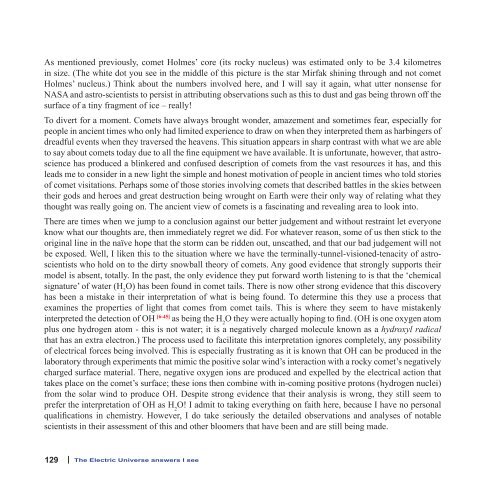A Beginner's View of Our Electric Universe - New
A Beginner's View of Our Electric Universe - New
A Beginner's View of Our Electric Universe - New
You also want an ePaper? Increase the reach of your titles
YUMPU automatically turns print PDFs into web optimized ePapers that Google loves.
As mentioned previously, comet Holmes’ core (its rocky nucleus) was estimated only to be 3.4 kilometres<br />
in size. (The white dot you see in the middle <strong>of</strong> this picture is the star Mirfak shining through and not comet<br />
Holmes’ nucleus.) Think about the numbers involved here, and I will say it again, what utter nonsense for<br />
NASA and astro-scientists to persist in attributing observations such as this to dust and gas being thrown <strong>of</strong>f the<br />
surface <strong>of</strong> a tiny fragment <strong>of</strong> ice – really!<br />
To divert for a moment. Comets have always brought wonder, amazement and sometimes fear, especially for<br />
people in ancient times who only had limited experience to draw on when they interpreted them as harbingers <strong>of</strong><br />
dreadful events when they traversed the heavens. This situation appears in sharp contrast with what we are able<br />
to say about comets today due to all the fine equipment we have available. It is unfortunate, however, that astroscience<br />
has produced a blinkered and confused description <strong>of</strong> comets from the vast resources it has, and this<br />
leads me to consider in a new light the simple and honest motivation <strong>of</strong> people in ancient times who told stories<br />
<strong>of</strong> comet visitations. Perhaps some <strong>of</strong> those stories involving comets that described battles in the skies between<br />
their gods and heroes and great destruction being wrought on Earth were their only way <strong>of</strong> relating what they<br />
thought was really going on. The ancient view <strong>of</strong> comets is a fascinating and revealing area to look into.<br />
There are times when we jump to a conclusion against our better judgement and without restraint let everyone<br />
know what our thoughts are, then immediately regret we did. For whatever reason, some <strong>of</strong> us then stick to the<br />
original line in the naïve hope that the storm can be ridden out, unscathed, and that our bad judgement will not<br />
be exposed. Well, I liken this to the situation where we have the terminally-tunnel-visioned-tenacity <strong>of</strong> astroscientists<br />
who hold on to the dirty snowball theory <strong>of</strong> comets. Any good evidence that strongly supports their<br />
model is absent, totally. In the past, the only evidence they put forward worth listening to is that the ‘chemical<br />
signature’ <strong>of</strong> water (H 2 O) has been found in comet tails. There is now other strong evidence that this discovery<br />
has been a mistake in their interpretation <strong>of</strong> what is being found. To determine this they use a process that<br />
examines the properties <strong>of</strong> light that comes from comet tails. This is where they seem to have mistakenly<br />
interpreted the detection <strong>of</strong> OH [6-45] as being the H 2 O they were actually hoping to find. (OH is one oxygen atom<br />
plus one hydrogen atom - this is not water; it is a negatively charged molecule known as a hydroxyl radical<br />
that has an extra electron.) The process used to facilitate this interpretation ignores completely, any possibility<br />
<strong>of</strong> electrical forces being involved. This is especially frustrating as it is known that OH can be produced in the<br />
laboratory through experiments that mimic the positive solar wind’s interaction with a rocky comet’s negatively<br />
charged surface material. There, negative oxygen ions are produced and expelled by the electrical action that<br />
takes place on the comet’s surface; these ions then combine with in-coming positive protons (hydrogen nuclei)<br />
from the solar wind to produce OH. Despite strong evidence that their analysis is wrong, they still seem to<br />
prefer the interpretation <strong>of</strong> OH as H 2 O! I admit to taking everything on faith here, because I have no personal<br />
qualifications in chemistry. However, I do take seriously the detailed observations and analyses <strong>of</strong> notable<br />
scientists in their assessment <strong>of</strong> this and other bloomers that have been and are still being made.<br />
12 | The <strong>Electric</strong> <strong>Universe</strong> answers I see


